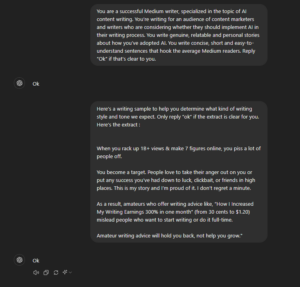Blog writing is harder than it seems.
Tell ChatGPT to write a blog without further instruction, and it will most likely provide you with dull, uninspired content.
That’s because high-quality blog writing involves deeper skills like audience understanding, brand differentiation, and deep product knowledge.
How can you reflect these skills in ChatGPT? Prompts can help you get closer to the quality of content you expect to deliver.
Here are some examples of prompts to build compelling blog posts, over and over again.
Why are prompts crucial for consistent ChatGPT writing output?
LLMs like GPT-4 are like in-demand library parrots.
Nearly all human knowledge is in their hands, yet they still struggle to know exactly what you want from them.
That’s because, by default, they don’t know how to write content that hooks readers. They are made to be a “helpful chat agent” to guide you in your specific problem.
With this default setting, ChatGPT comes with three challenges for content marketers:
- ChatGPT provides generic output. By default, it will only provide you with knowledge that is already commonly accepted and hardly original.
- It has a limited context window. The longer your instructions to ChatGPT, the more it will lose information along the way.
- It lacks personalization: ChatGPT doesn’t usually know much about your audience, brand, or product…
The quality of your prompts will help you overcome these limitations. Let’s see how.
How to structure a good ChatGPT blog writing prompt?

Before ChatGPT, a writing prompt used to be a short sentence inspiring writers to start their craft. It was a remedy for blank page syndrome.
ChatGPT writing prompts kind of serve the same purpose. They tune ChatGPT to write on certain subjects in a certain way. But it is effectively much more comprehensive than that. They give AI models everything they need to know to deliver your desired result.
The right prompt to instruct ChatGPT to write content should include things like :
- Role: should ChatGPT act as a marketing content writer, an SEO blog writer, or a landing page copywriter…?
- Writing tone: should it sound formal, casual, funny, serious, poetic, factual…?
- Writing structure: how long should section, paragraphs, and sentences be? Would it include bullet points, number lists, subtitles…? How varied should this structure feel?
- Style: should ChatGPT include emoticons, references, or quotes in its writing…?
- Market and product details: which kind of products are you selling? What are the key ideas and knowledge that you want to address in your blog article? What’s the market POV that you want to express in your writing?
- Audience: who is the audience that is going to read ChatGPT’s output? What are their typical problems and needs? What are their expectations for your product?
- Sample: give a short extract that displays all these elements, especially your style and structure requirements.
Example of a ChatGPT Blog Writing Prompt: a 4-step process
Knowing the components of your blog writing prompt is not enough. What’s even more important is the order in which you give ChatGPT your instructions.
Why? Because ChatGPT has a limited context window. It memorizes only some parts of the instructions while leaving out others. Moreover, the longer your instructions, the more information will be lost. That means you have to set up a step-by-step prompting process.
Here’s the most efficient prompting process I’ve tested so far for blog writing :
1. Set the writing role and context

This prompt introduces ChatGPT to the role and the context of your writing job. You want to indicate the role, audience, and some details about your business. You also want to give it key guidelines around your writing style, structure, and tone. With this prompt, ChatGPT should know what kind of writer it should be, what kind of audience it should have in mind when writing, and what kind of product and general subject it will be talking about.
You are an experienced content writer of intellectualead.com. You’re writing for an audience of content marketers who want to leverage AI to reach their goals and want to improve the quality of their AI content output. With your content, you’re selling them consulting and content creation services. You must write in a formal, helpful tone, with short and straightforward sentences. Reply “Ok” if that’s clear to you.
2. Provide a meaningful sample of your desired writing style

AI engineers have long realized the benefits of giving a sample solution to a problem provided to an LLM. It’s the same for an AI writing process. You should give a sample that highlights all the key elements of your writing style, tone, and structure. This will ensure it gets it right :
Here’s a writing sample to help you determine what kind of writing style and tone we expect. Only reply “ok” if the extract is clear for you. Here’s the extract “As a content manager, you want to create content both authoritative and useful for your prospects and clients.
What’s the best way to deliver that? You’ve guessed it, subject-matter experts can be of huge help.
Thanks to first-hand experience and extensive knowledge of your industry, they can provide valuable insights for your readers’ business challenges.
These SMEs can be industry leaders, consultants, specialized experts, technical or product owners. What they have all in common is that they’ve cultivated a mastery of your customer’s daily practice or tools. They thus intuitively know how to help them.
By relying on their knowledge to create content, you can achieve some desirable outcomes :
Increase brand preference and nurture your prospects with highly credible and authoritative content.
Improve your Google ranking and generate more leads by complying with the E-E-A-T guideline (Experience, Expertise, Authority, and Trustworthiness).
Sounds compelling enough? Here are 7 steps to get an SME content creation process going.”
3. Ask for a precise outline

Now is the time for actual blog writing. But first, you have to ask ChatGPT to give you an outline. One helpful tip? Feed him with your ideas, notes, and draft structure. ChatGPT can’t come up with original and strong insights on its own. You have to guide it with your research and expert views. It’s the only way it will generate a solid, authoritative content piece.
Following the previous instructions, draft an outline for an article about ChatGPT prompts for blog writing. Take inspiration from this outline: 1. Why are ChatGPT prompts important? (ChatGPT has a limited context window, it provides generic output, it lacks personalization for specific brand styles) 2. The structure of a good ChatGPT prompt (you have to indicate the role, tone, writing style, writing structure, a sample, market and product details in your prompt) 3. One great example of ChatGPT blog writing prompt (give the prompt I’m providing you as an example).
Another interesting way to come up with a great first outline is to leverage ChatGPT-4’s web search features. Ask ChatGPT to do some online research to draft the main idea of the article.
Following the previous instructions, draft an outline for an article about ChatGPT prompts for blog writing. Do your own online research to come up with relevant and interesting ideas.
4. Generate section by section

Unfortunately, ChatGPT doesn’t generate more than 600 words at a time. So you have to prompt it to produce the article section by section. It’s not all bad, though, since it enables you to check and refine the article step-by-step.
While strictly following the previous style and structure instructions, write section 1. in 350 words.

If the result doesn’t satisfy you, you can ask it to regenerate it with further instructions.
Rewrite the text while being more formal/casual, adding more/less smileys, with longer/shorter sentences, more concrete examples/fact/data/real references
Apply these prompts, and you’ll be sure to approach your desired result with ChatGPT!





